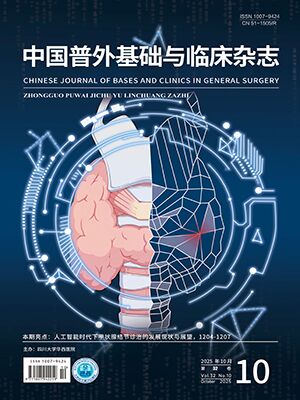| 1. |
Chen W, Zheng R, Baade PD, et al. Cancer statistics in China, 2015. CA Cancer J Clin, 2016, 66(2): 115-132.
|
| 2. |
Siegel RL, Miller KD, Jemal A. Cancer statistics, 2017. CA Cancer J Clin, 2017, 67(1): 7-30.
|
| 3. |
Mullooly M, McGowan PM, Crown J, et al. The ADAMs family of proteases as targets for the treatment of cancer. Cancer Biol Ther, 2016, 17(8): 870-880.
|
| 4. |
Narita D, Seclaman E, Ursoniu S, et al. Increased expression of ADAM12 and ADAM17 genes in laser-capture microdissected breast cancers and correlations with clinical and pathological characteristics. Acta Histochem, 2012, 114(2): 131-139.
|
| 5. |
Xu M, Zhou H, Zhang C, et al. ADAM17 promotes epithelial-mesenchymal transition via TGF-β/Smad pathway in gastric carcinoma cells. Int J Oncol, 2016, 49(6): 2520-2528.
|
| 6. |
Vargas AJ, Thompson PA. Diet and nutrient factors in colorectal cancer risk. Nutr Clin Pract, 2012, 27(5): 613-623.
|
| 7. |
Cheng CJ, Bahal R, Babar IA, et al. MicroRNA silencing for cancer therapy targeted to the tumour microenvironment. Nature, 2015, 518(7537): 107-110.
|
| 8. |
Oikawa H, Maesawa C, Tatemichi Y, et al. A disintegrin and metalloproteinase 17(ADAM17) mediates epidermal growth factor receptor transactivation by angiotensinⅡ on hepatic stellate cells. Life Sci, 2014, 97(2): 137-144.
|
| 9. |
Shen H, Li L, Zhou S, et al. The role of ADAM17 in tumorigenesis and progression of breast cancer. Tumour Biol, 2016, [Epub ahead of print].
|
| 10. |
Rios-Doria J, Sabol D, Chesebrough J, et al. A Monoclonal antibody to ADAM17 inhibits tumor growth by inhibiting EGFR and non-EGFR-mediated pathways. Mol Cancer Ther, 2015, 14(7): 1637-1649.
|
| 11. |
方文勝. 去整合素-金屬蛋白酶17在結直腸腺瘤和癌中的表達及臨床意義. 天津: 天津醫科大學, 2012.
|
| 12. |
Groot AJ, Cobzaru C, Weber S, et al. Epidermal ADAM17 is dispensable for notch activation. J Invest Dermatol, 2013, 133(9): 2286-2288.
|
| 13. |
Dosch J, Ziemke E, Wan S, et al. Targeting ADAM17 inhibits human colorectal adenocarcinoma progression and tumor-initiating cell frequency. Oncotarget, 2017, 8(39): 65090-65099.
|
| 14. |
Wang XJ, Feng CW, Li M. ADAM17 mediates hypoxia-induced drug resistance in hepatocellular carcinoma cells through activation of EGFR/PI3K/Akt pathway. Mol Cell Biochem, 2013, 380(1-2): 57-66.
|
| 15. |
Mu?oz-Pinedo C. Signaling pathways that regulate life and cell death: evolution of apoptosis in the context of self-defense. Adv Exp Med Biol, 2012, 738: 124-143.
|
| 16. |
Visconti R, D'Adamio L. Functional cloning of genes regulating apoptosis in neuronal cells. Methods Mol Biol, 2007, 399: 125-131.
|
| 17. |
張乙川, 劉峰, 王俊, 等. 雷公藤紅素誘導人肝癌SMMC-7721細胞凋亡研究. 中國普外基礎與臨床雜志, 2016, 23(1): 48-51.
|
| 18. |
Hawley SA, Ross FA, Gowans GJ, et al. Phosphorylation by Akt within the ST loop of AMPK-α1 down-regulates its activation in tumour cells. Biochem J, 2014, 459(2): 275-287.
|
| 19. |
殷舞, 鐘曉剛, 黃順榮, 等. PI3K/Akt/mTOR信號通路在大腸腺瘤惡性轉化中的表達及意義. 廣東醫學, 2013, 34(2): 238-240.
|
| 20. |
Meng X, Hu B, Hossain MM, et al. ADAM17-siRNA inhibits MCF-7 breast cancer through EGFR-PI3K-AKT activation. Int J Oncol, 2016, 49(2): 682-690.
|
| 21. |
涂業桃, 舒靜, 田文林, 等. 下調血管生成素基因表達對膀胱癌移植瘤生長及p-AKT、p-GSK3β、p-mTOR表達的影響. 廣東醫學, 2015, 36(4): 501-504.
|
| 22. |
Chiara F, Rasola A. GSK-3 and mitochondria in cancer cells. Front Oncol, 2013, 3: 16.
|
| 23. |
Jin Z, Cheng X, Feng H, et al. Apatinib inhibits angiogenesis via suppressing Akt/GSK3β/ANG signaling pathway in anaplastic thyroid cancer. Cell Physiol Biochem, 2017, 44(4): 1471-1484.
|
| 24. |
Liu RM, Sun DN, Jiao YL, et al. Macrophage migration inhibitory factor promotes tumor aggressiveness of esophageal squamous cell carcinoma via activation of Akt and inactivation of GSK3β. Cancer Lett, 2018, 412: 289-296.
|
| 25. |
Sokolosky M, Chappell WH, Stadelman K, et al. Inhibition of GSK-3β activity can result in drug and hormonal resistance and alter sensitivity to targeted therapy in MCF-7 breast cancer cells. Cell Cycle, 2014, 13(5): 820-833.
|




